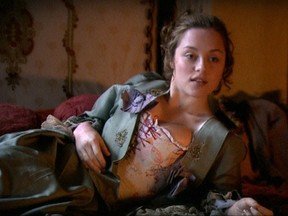 Hogarth is said to have been inspired in his series by a real person.
Hogarth is said to have been inspired in his series by a real person.
The second picture shows a courtesan, who he was commissioned to draw. He apparently mused then upon her earlier and later life, which became A Harlot's Progress. There is no indication, in reality, that he followed the same woman for the rest of her life.
However, every other person in his paintings is real. For example, there really was an Elizabeth Needham, known as 'Mother' Needham, who procured girls for prostitution. She was sentenced to stand in the pillory twice.
The first time, magistrates allowed her to lie down in front of the pillory, with an armed guard around her for protection. That didn't stop the crowd pelting her with missiles though. She was effectively stoned practically to death, then died of her injuries before she could face the pillory for a second time.
Her image was widely circulated at the time and Hogarth blatantly placed her, in her role, in the first scene in A Harlot's Progress. He was painting that series in the same year as 'Mother' Needham was killed.
Hogarth called his 'harlot' Moll Hackabout. Moll is both short for Mary and a colloquial term for a prostitute. But it also recalled one of the best-selling novels of the time, Moll Flanders by Daniel Defoe. The heroine of that book also got by on her womanly charms.
The surname used would have been equally recognizable by 18th century society. Kate Hackabout was a prostitute, whose brothel was broken up by Sir John Gonson in August 1730. He is the magistrate depicted doing exactly the same to Moll's disorderly house in the third painting.
Kate was arrested in reality and consigned to jail. Her brother Francis Hackabout was hanged at Tyburn, as a highwayman, in the same year. All of this was recent news, when Hogarth was painting A Harlot's Progress.
There was no real Mary Collins, but there was Kate Hackabout. Could she have been his muse as shown in this movie?




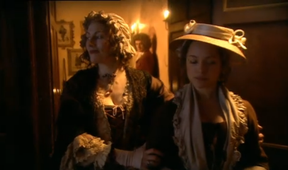 Those familiar with Hogarth's work can already guess the plot of this movie.
Those familiar with Hogarth's work can already guess the plot of this movie.



 Hogarth is said to have been inspired in his series by a real person.
Hogarth is said to have been inspired in his series by a real person. 



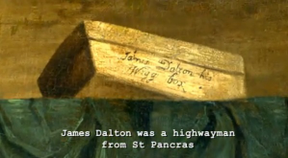 Something that I absolutely adored about the movie A Harlot's Progress was the way that sound was used.
Something that I absolutely adored about the movie A Harlot's Progress was the way that sound was used.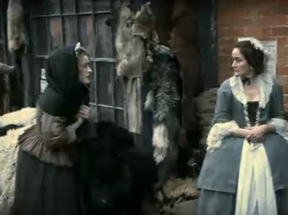 A Harlot's Progress had a cast-list which reads like a mini Who's Who of British actors. Familiar faces cropped up in cameos throughout the film.
A Harlot's Progress had a cast-list which reads like a mini Who's Who of British actors. Familiar faces cropped up in cameos throughout the film.


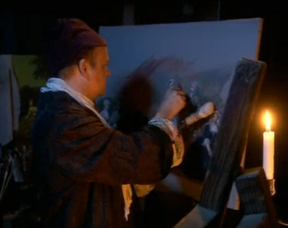 I watched this movie without any knowledge about William Hogarth, nor even his famous art series. The first thing I did after the credits rolled was to go and discover more (or, at least, how true the story had been).
I watched this movie without any knowledge about William Hogarth, nor even his famous art series. The first thing I did after the credits rolled was to go and discover more (or, at least, how true the story had been).



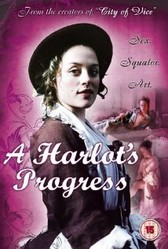

 St Tydecho's Churches in West Waleson 09/03/2014
St Tydecho's Churches in West Waleson 09/03/2014
 Goodies for an Outlander Premiere Partyon 03/06/2015
Goodies for an Outlander Premiere Partyon 03/06/2015
 Holocaust Memorial Day Interview with Rainer Höss, Grandson of Rudolf Architect of Auschwitzon 01/24/2015
Holocaust Memorial Day Interview with Rainer Höss, Grandson of Rudolf Architect of Auschwitzon 01/24/2015
 Romantic Valentine Gifts for an Outlander Fanon 01/16/2015
Romantic Valentine Gifts for an Outlander Fanon 01/16/2015

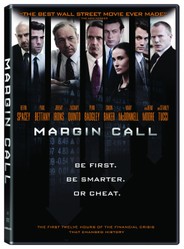
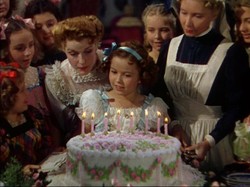
Comments
I really enjoyed it! Like I said, it was all new to me, so it was even more fascinating.
Oh wow that sounds like a really awesome movie. I'll put it on my bucket list to watch.
I'm glad that you are, because then we'll get an article about Hogarth out of you and I get to learn more about him! :D
Okay Jo, now I've got to watch this. Thanks for the article.